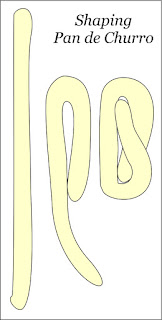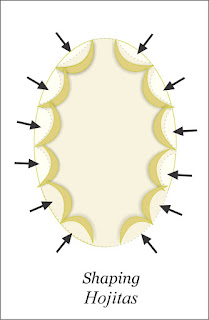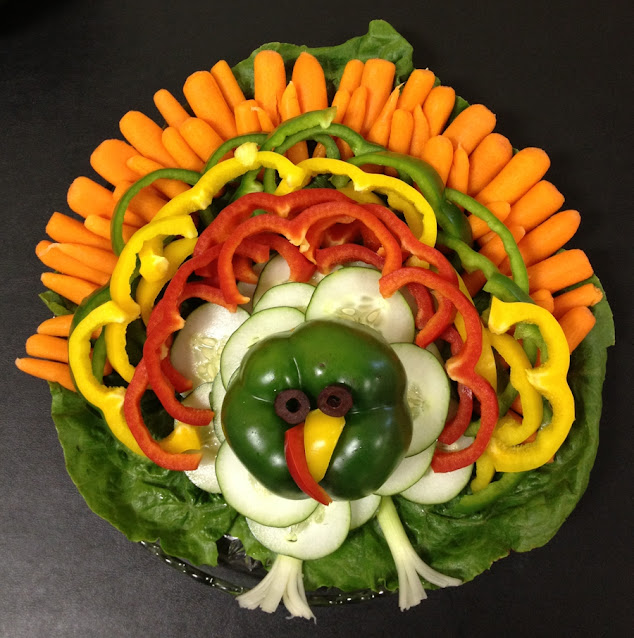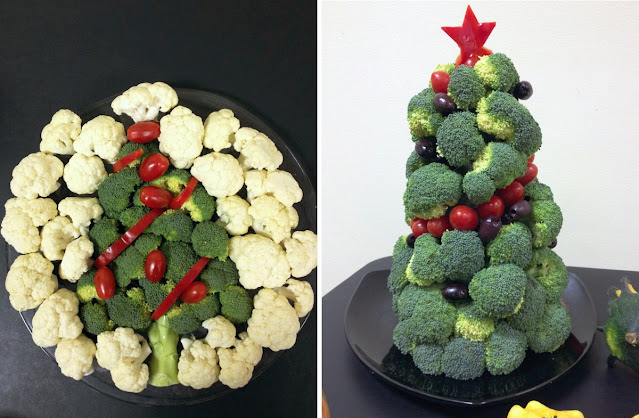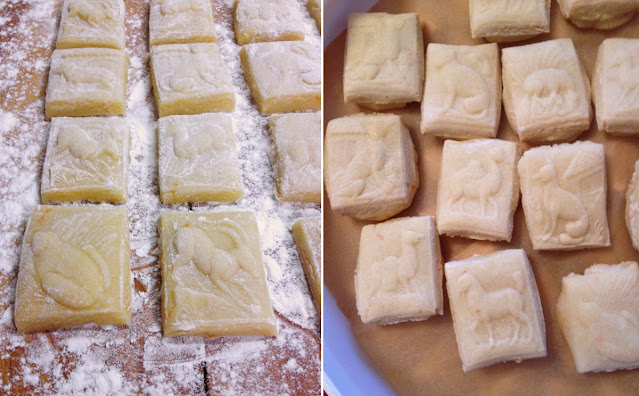| Guatemalan Pan Frances |
Another food that I haven't made in what seems like forever, but in reality, I had made at least twice since returning to the U.S in late 1981 is Paches, Pronounced PAH-chez, the "e" with a short ĕ sound, as in set, or let. Before getting into Paches, a little background.
Disambiguation:
Guatemalan tamales are not at all like the Mexican tamales one finds in the southwest U.S and other places where pockets of Mexican communities take root. I have nothing against Mexican tamales, and buy them often enough as they are delicious, but the closest thing to a Mexican tamal (Tamal = singular form) found in Guatemala is called a Chuchito (literally translated to small dog, or puppy). Chuchitos, also wrapped in dried corn husks as with Mexican tamales, are made quite similarly to Mexican Tamales, but Guatemalan Tamales are a different thing altogether.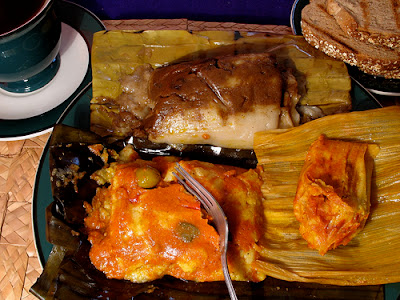 |
| Clockwise from top: Sweet Tamal - Chuchito - Savory Tamal |
For one thing, Guatemalan Tamales (Tamales = plural) are large, and are usually eaten as a meal alone, or with a side of eggs or black beans, or both. Some Pan Frances on the side and you are all set. These tamales are a huge process to create, and well-worth it, particularly with some help. They are made with a base of corn masa, or rice flour, or a combination of both. Topping this is a sauce ("recado") that can be savory and tinted with annatto seeds - or - lightly sweetened, with chocolate added to the sauce. In the center is a piece of meat (chicken, turkey, pork, even duck), and stuck in around the periphery are 1 prune, 1 raisin, one olive, one caper, a slivered almond, and over top of all a strip of red pimiento pepper (not everyone uses all these extras, called "adornments" - some use only 1 or two). These are wrapped in a green leaf called Maxan or Mashan. Many places say that these are wrapped in banana leaves, and while they can be, banana leaves are far more fragile and tear too easily. Maxan leaves are stronger, tear to size easily and do not need to be immersed in boiling water to make them flexible.
And now, on to the Paches
Paches, while made the same size as a Guatemalan Tamal, have their masa base as potatoes. Instead of having the sauce poured over top of the base as with tamales, it is mixed right in. Generally made with a piece of pork inside, it can also be made with chicken. And, instead of the many additions, just one olive is inserted alongside the meat. Sometimes, a single, whole, long, fresh green chili pepper is laid over top before wrapping. Paches have similar flavor to tamales, but are far less work to make. Somewhere I read that they originated in Quetzaltenango, as potatoes are a crop there. Somehow, along the way, Thursdays became Paches Day, and most often they are found sold from huge baskets on street corners, in the markets or outside of grocery stores. Only on Thursdays. |
| One of my Paches served on its parchment wrapper |
I loved paches while living in Guatemala, and still do, although I hadn't made them for many, many years. And, I have no ready access to Maxan leaves. Instead, I used parchment paper, something I have also done when making tamales here in the U.S. with no access to Maxan leaves. The final outcome lacks that green flavor from the leaf, but the pache is still tremendously tasty.
 |
| Peel cooked potatoes, pass through food mill, add in recado and mix |
Making Paches
To make Paches, there are three main steps:- Make the "recado" or sauce
- Cook the pieces of meat
- Cook the potatoes whole, peel and rice them or pass through a food mill
Once the potatoes are ready, add in the butter (a mix of butter and lard is also good) and the recado/sauce and stir well. Taste for salt. Despite cooking the potatoes in salted water, they need salt to make the taste right. Amount is subjective; start with a teaspoon of salt and add little by little until it suits your taste, mixing well between additions.
And then Comes the Wrapping
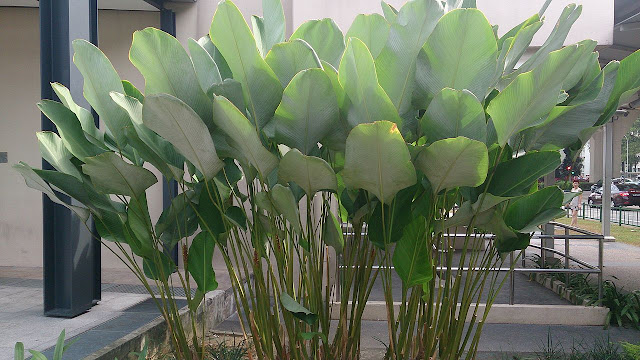 |
| Maxan Leaves - Calathea Lutea |
If one is lucky enough to have maxan leaves for wrapping, you will need sections at least 12 to 14-inches square (more or less square). On top of this wrapper piece of leaf, a second, smaller "serving leaf" is set atop the first. This second serving leaf is generally smaller, a minimum of about 9-inches squar-ish. It can be as large as the first leaf, but does not need to be. Once paches are wrapped, steamed and ready to serve, the packet is unwrapped, and the inner leaf, along with the pache, is slid onto a plate for serving.
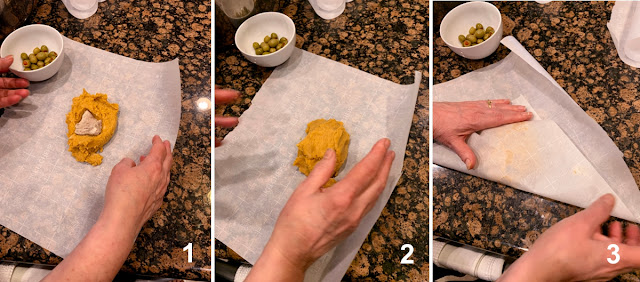 |
| Steps 1 to 3 of wrapping Paches |
To make the packets using parchment, no inner "leaf" is needed.
- Step 1: lay out the parchment square at an angle with one point towards you. Set an amount of the pache mixture, at least a cup, but preferably 1½ to 1¾-cup worth in the center of the paper. Add in one chunk of meat and one olive.
- Step 2: If the potato mixture is very stiff, pat the mixture to cover the meat.
- Step 3: Fold the bottom point upwards to cover the mixture.
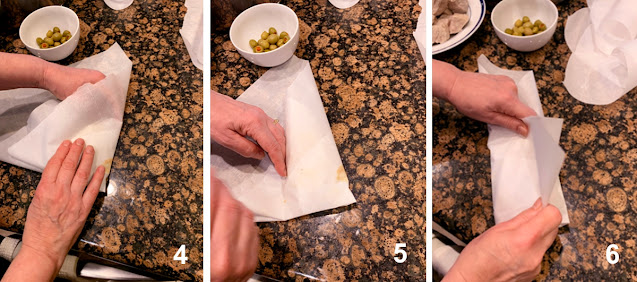 |
| Steps 4 to 6 of Wrapping Paches |
- Step 4: Neaten edges of parchment, pressing in around the mixture, then fold the right point left, across the mixture.
- Step 5: Neaten the edges, tucking in close to the pache mixture.
- Step 6: Take the left point and bring to the right, across the packet. If the point is too long, simply fold it around to the under side of the packet.
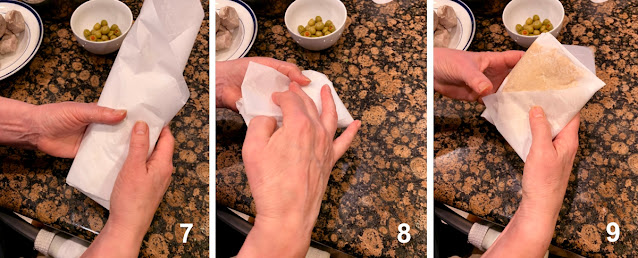 |
| Steps 7 to 9 of Wrapping Paches |
- Step 7: At this point, the packet can remain on the flat surface, or it can be lifted in hands.
- Step 8: Take the top point and neatly fold it downwards to cover the whole packet.
- Step 9: Flip the packet so the last point is now pointing upwards. This is the orientation of the packets to place into a pot for steaming.
Preparing a pot (or two) for Steaming
To steam tamales, tamalitos, chuchitos / Mexican tamales, it was explained to me thusly: The bundles can be tied closed, to prevent the packet leaking.Or.
The bundle can be placed with the last fold upwards and leaning one against the next, keeping them at an upwards slant, that last fold will contain the mixture and prevent leakage. I have seen photos of batches of leaf-wrapped tamales, all tied neatly, and haphazardly placed in a pot. Instead, I was taught by various Maya ladies that the goal is to keep the center of the pot open, so steam can hit all the tamales evenly. To do this, they all need to be placed neatly around the edge of the large pot, on a rack, or a rack made from various thick stems or vein pieces of the Maxan leaves, to keep them off the bottom of the pot and out of the steaming water. If your pot is very large, you may be able to fit a second row of paches (tamales, chuchitos) inside the first, while still maintaining a small center hole for steam. Top the standing packets with another leaf, tucked down around the edges, cover tightly with a lid, and steam for an hour, checking often to ensure there is water in the pot, adding more if needed.
I have round racks for cooling cakes. They are about 9-inches diameter and fit neatly into my soup pots. Lacking the leaves and their thick veins to use, these racks are perfect. I used a small jar to lean the first packet against, keeping it mostly upright, following around the perimeter of the pot, leaning each packet against the last, until reaching the first one. Remove the jar and set the last packet in. I have not bothered with covering the top with another piece of parchment, though when I do have leaves to hand, I do tuck the leftover pieces over top of the standing packets before covering with the lid. Partly, this helps with not steaming the pot dry, as the condensation collecting inside the top leaf just slides back into the pot. If not using the extra precaution, do keep a sharp eye and ear out for the pan running dry - add in more water before this happens.
The recipe:
Paches Quetzaltecos
Makes about 15
1 to 1¼ pounds pork roast, cut in 15 - 18 pieces
5 pounds potatoes, cooked whole, peeled, passed through food mill
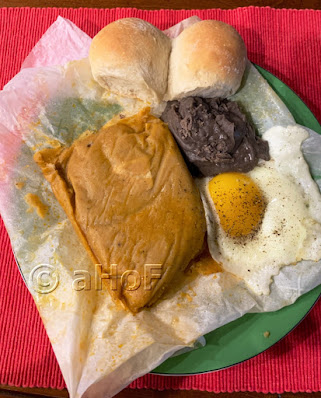 |
| Pache for breakfast with egg, beans and pan frances |
2 teaspoons salt
1 bay leaf
8 ounces butter or lard
1 bunch maxán leaves for wrapping, washed (or 14 x 14-inch parchment)
15 olives
15 long, thin green chiles, optional
FOR THE RECADO (SAUCE):
1 cup tomatillos, broiled, blistered/charred
6 Roma tomatoes, broiled, blistered/charred
1 onion, quartered & separated, broiled until charred at edges
2 garlic cloves, broiled to light brown
1 chillie guaque or guajillo, seeds removed, soaked in boiling water
1 pasilla chile, seeds removed, soaked in boiling water
1 ounce pumpkin seeds (3 TB)
1 ounce sesame seeds (¼ cup)
5 whole allspice berries
10 whole black peppercorns
1 (2-inch) piece cinnamon stick
5 whole cloves
½ ounce annatto seeds (1½ TB) OR -
1½ teaspoons annatto powder
Place the cubed meat into a pot with water to just cover. Add in about 1 teaspoon of the salt and a bay leaf and bring to boil. Reduce to simmer, cover and cook until the meat is tender, about 45 minutes. Use immediately or cool and refrigerate for up to 3 days.
For the sauce: If using whole annatto seeds, heat the annatto seeds in a tablespoon or so of oil (or water), as needed and then press them, rubbing against a sieve, getting as much color out into the oil as possible. Pour this oil in a blender container with the charred tomatillos, tomatoes, onion, garlic & soaked, drained chilies. Squeeze out the soaked bread slightly and add to the blender. Toast the pumpkin seeds and sesame seeds separately in a dry skillet, then remove to the blender. Toast together in the same dry skillet the allspice, peppercorns, cinnamon and cloves until fragrant, then add to blender and puree the mixture until fine. (If preferred, grind these last 5 spices in a spice grinder, then add to the blender.) In a frying pan, heat 2 oz of the butter or lard and pour in the blended ingredients and fry, stirring, until slightly thickened. Once thickened, mix the sauce with the riced or milled potatoes, add in the remaining 6 ounces of butter and check the flavor for salt, adding the second teaspoon of salt, plus more if deemed needed for flavor.
Clean and cut the leaves to about 14 x 14-inches (or use similarly sized squares of parchment). If using leaves, have a second, smaller leaf set in the center of the larger leaf, for serving, later. Hold the square of leaf/parchment in hand (or set on a flat surface), diagonally, with a point towards you and place a large spoonful (at least 1½ to 1¾ cups worth) of the mixture in the center; set a piece of the cooked pork into the center of the potato mixture, add one green olive (typically with the pit). Make sure the meat is covered with the potato mixture. If available, set one long, thin, green, whole chili pepper on top, then wrap, folding as shown above: bottom point upwards, right point over to the left, left point over to the right, then top point down. Flip packet vertically, so final point is now upwards, and set at an upright angle in the prepared pot with rack in bottom. The packet should be placed so that the last folded point is angled towards the bottom, thus keeping it closed and intact, pressed against the previous one. Once the packets make a ring around the outer edges of the pan, leaving a center hole, pour 2 cups of water into the pot into the center hole, cover with a tight fitting lid, bring to boil. Reduce to a simmer, then time for one hour, keeping watch that the water does not all boil out, adding more if needed. The paches should not be setting IN the water, but be steamed only.
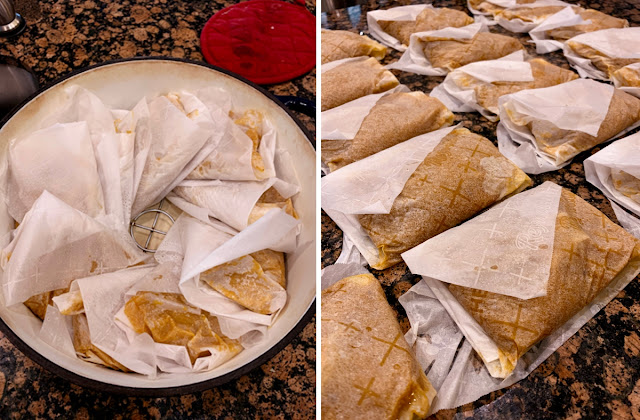 |
| Wrapped Paches leaning around inside of pot, then cooling on counter |
Once the hour is up, use a flat spatula to remove the packets to a clean surface to cool, then store in the refrigerator.
To heat and serve, place a small amount of water in a skillet with lid, set in as many paches as will fit comfortable, then cover and cook for about 20 minutes. If frozen, do the same, but allow at least 40 minutes to heat all the way through. Unwrap and either slide off leaf or paper onto plate or set the leaf/paper on plate and fold large edges under themselves.
My passion is teaching people how to create a harmony of flavors with their cooking, and passing along my love and joy of food, both simple or exotic, plain or fancy. I continue my journey in ethnic and domestic cuisines, continuing my journey to explore diverse culinary experiences and hopefully to start you on a journey of your own. Join me also at A Harmony of Flavors on Facebook, and Pinterest.


